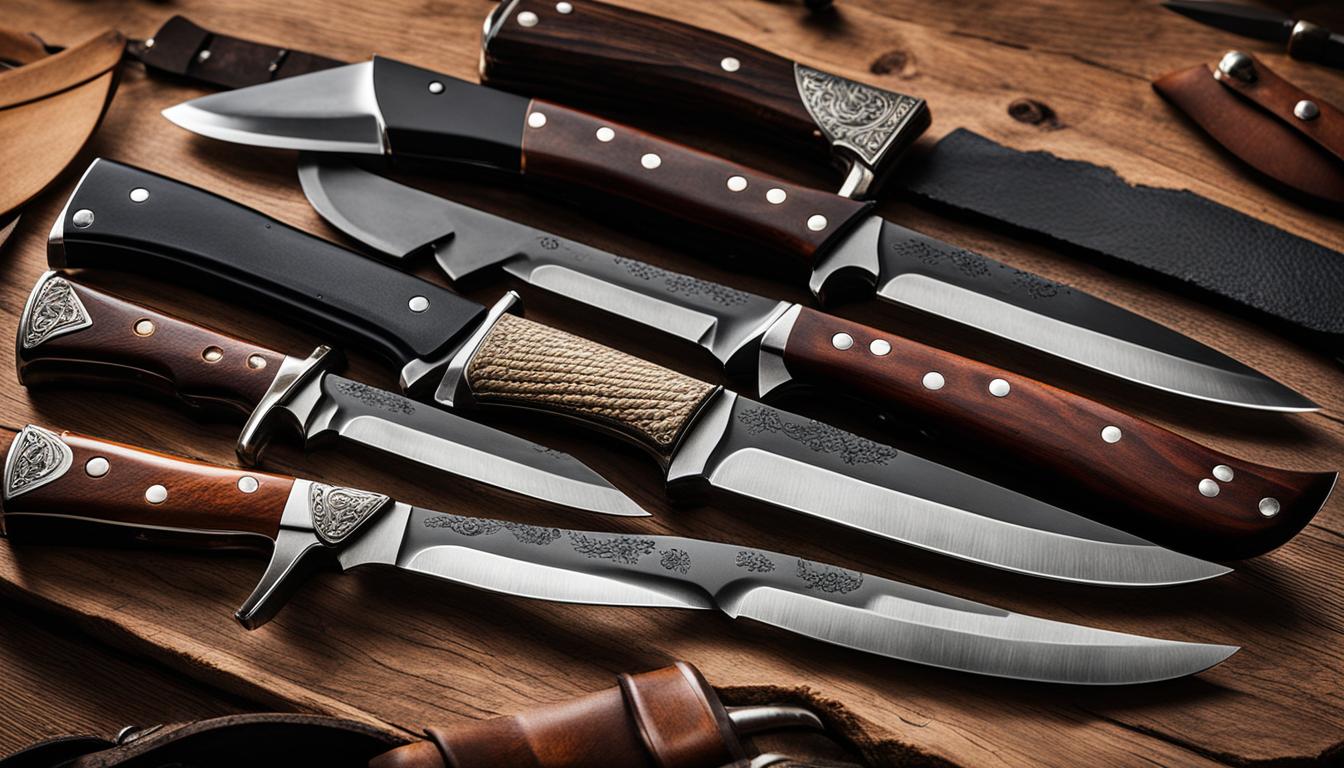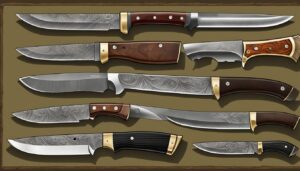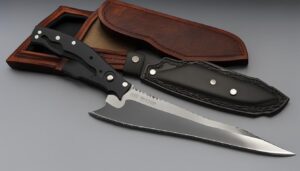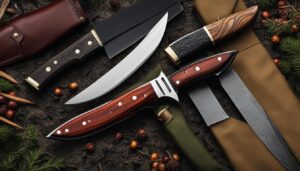No hunter is fully prepared without a knife. The hunting knife is one of the most vital pieces of gear for any hunting adventure. This article provides a thorough guide to traditional hunting knives for beginners. It covers the history of hunting knives, their uses, types of hunting knives, and optional features. By understanding the basics, beginners can choose the right knife for their needs and make their first hunting adventure a success.
Key Takeaways:
- Traditional hunting knives are essential for beginners in the world of hunting.
- Understanding the history of hunting knives helps in making an informed decision.
- Hunting knives serve various purposes, including gutting, skinning, deboning, butchering, and caping.
- There are different types of hunting knives, such as camp knives, Bowie knives, caping knives, skinning knives, and boning knives.
- Optional features like gut hooks, blade styles, and handle materials enhance the functionality of hunting knives.
A Brief History of the Hunting Knife
The hunting knife has a rich and ancient history that dates back to the Stone Age. Early humans made hunting knives by fashioning sharp blades from materials such as stone, shell, and bone. These primitive knives served as essential tools for hunting and survival, allowing our ancestors to procure food and protect themselves from predators.
Throughout history, the design and craftsmanship of hunting knives evolved significantly. The contributions of individuals like Jim Bowie and R.W. Loveless played a crucial role in shaping the modern hunting knife as we know it today.
“The history of hunting knives is deeply intertwined with the legendary Bowie knife. This iconic knife, popularized by Jim Bowie in the early 19th century, featured a distinct clip point blade and became renowned for its durability and versatility. The Bowie knife’s influence on hunting knife design cannot be overstated.”
The popularity of hunting knives grew further with the introduction of the Swiss Army knife, a multi-functional tool that often includes a hunting blade. Additionally, the Buck Model 110 Hunting Knife gained fame for its innovative folding design, making it a preferred choice for many hunters.
In summary, the history of hunting knives is a testament to their enduring importance in human civilization. From humble beginnings in the Stone Age to iconic designs like the Bowie knife and the Swiss Army knife, hunting knives have played a vital role in hunting, survival, and outdoor pursuits for countless generations.
Uses of Hunting Knives
When it comes to traditional hunting, a hunting knife is an essential tool that serves a variety of purposes. Understanding the different uses of hunting knives can help beginners choose the right knife for their needs. Let’s explore the various tasks that hunting knives can perform:
- Gutting: Gutting is an important step in field dressing game, which involves removing the organs. A hunting knife with a sharp, sturdy blade is necessary for this task.
- Skinning: Skinning requires precision and finesse to remove the animal’s skin without damaging the underlying muscles or tissues. A hunting knife with a curved, thin blade is ideal for this purpose.
- Deboning: Deboning involves separating the meat from the bone. A narrow and flexible boning knife is perfect for this task, allowing for easy maneuverability.
- Butchering: After field dressing, the meat needs to be cut into smaller portions. A hunting knife with a strong, durable blade is essential for efficient butchering.
- Caping: Caping refers to the process of skinning the head and neck of an animal for trophy preparation. A hunting knife with an upturned point is specifically designed for this delicate task.
- Hog Hunting: Hunting knives can also be used for specialized tasks like hog hunting. These knives are designed for specific features such as gut hooks or serrated edges to suit the requirements of hog hunters.
By understanding the different uses of hunting knives, beginners can select a knife that is suited to their specific needs, ensuring a successful and enjoyable hunting experience.
Table: Comparison of Hunting Knife Uses
| Task | Required Knife |
|---|---|
| Gutting | Hunting knife with a sharp, sturdy blade |
| Skinning | Hunting knife with a curved, thin blade |
| Deboning | Narrow and flexible boning knife |
| Butchering | Hunting knife with a strong, durable blade |
| Caping | Hunting knife with an upturned point |
| Hog Hunting | Specialized hunting knife with gut hooks or serrated edges |
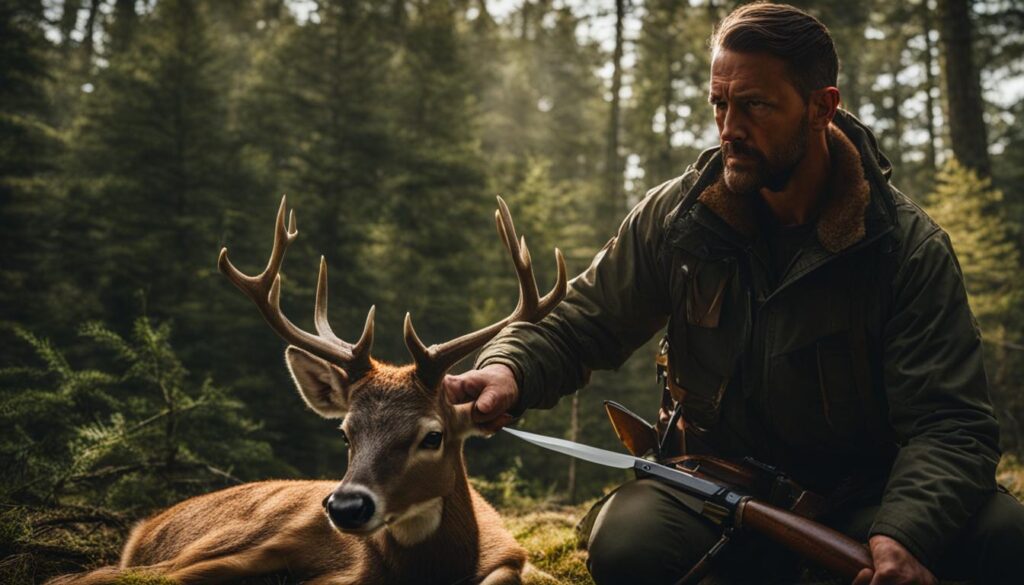
(adsbygoogle = window.adsbygoogle || []).push({});
“A good hunting knife is like a trusted companion in the wild. Whether it’s gutting, skinning, deboning, butchering, or caping, having the right knife for the task at hand is crucial. The versatility of hunting knives makes them indispensable for any hunter.”
Types of Hunting Knives
When it comes to choosing a hunting knife, there are several types to consider, each with its own unique design and purpose. Understanding the different types of hunting knives can help beginners make an informed decision based on their specific needs and preferences.
Folding Knives
One popular type of hunting knife is the folding knife, also known as a pocket knife. These knives are versatile and convenient, as they can be easily carried in a pocket or backpack. Folding knives typically have a blade that folds into the handle, making them compact and safe to transport. They are ideal for everyday tasks, such as field dressing and small game hunting.
Fixed-Blade Knives
Fixed-blade knives are another common type of hunting knife. As the name suggests, these knives have a blade that is permanently fixed in place, providing added strength and durability. Fixed-blade knives are known for their reliability and versatility, making them suitable for a wide range of hunting tasks, including skinning, gutting, and butchering game.
Gutting Knives
Gutting knives are specialized hunting knives designed specifically for field dressing game. They typically have a narrow, curved blade with a curved tip, allowing for precise and efficient cutting of the animal’s abdomen. These knives are essential for removing the internal organs during field dressing, ensuring a clean and efficient process.
Caping Knives
Caping knives are designed for the intricate process of creating animal trophies. They have a small, upturned point and a narrow blade, allowing for delicate and precise cutting around the head and neck of the animal. Caping knives are commonly used by hunters who wish to preserve the hide of their trophy game for mounting purposes.
| Type of Hunting Knife | Description |
|---|---|
| Folding Knives | Versatile and compact, ideal for everyday tasks |
| Fixed-Blade Knives | Durable and reliable, suitable for various hunting tasks |
| Gutting Knives | Narrow, curved blades for efficient field dressing |
| Caping Knives | Small, upturned blades for delicate trophy preparation |
Optional Features of Hunting Knives
When it comes to choosing a hunting knife, there are several optional features to consider that can enhance its functionality and improve your overall hunting experience. These features include:
- Gut Hook: A gut hook is a small, curved blade on the spine of the knife that allows hunters to easily and cleanly open the abdomen of game animals for field dressing. It simplifies the process by providing a precise entry point and reducing the risk of accidentally puncturing internal organs.
- Blade Style: The blade style of a hunting knife can vary, and each style has its own advantages. The most common blade styles for hunting knives include the clip point, drop point, and skinning blades. The clip point is versatile and suitable for a range of tasks, while the drop point offers extra strength and control. Skinning blades, on the other hand, have a curved shape that makes them ideal for precise skinning and reducing the risk of damaging the meat.
- Handle Material: The handle material of a hunting knife is crucial for durability and grip. Options range from synthetic materials like G-10 and Micarta, which offer excellent grip and durability, to natural materials like wood and bone, which provide a traditional aesthetic and a comfortable feel in the hand.
“The gut hook is a game-changer when it comes to field dressing. It saves time and makes the process much easier, especially when dealing with large animals.”
By understanding these optional features, you can choose a hunting knife that best suits your needs and preferences. Whether you prioritize a gut hook for efficient field dressing, a specific blade style for versatile use, or a handle material that offers both durability and aesthetic appeal, considering these features will help you make an informed decision.
| Optional Feature | Description |
|---|---|
| Gut Hook | A small, curved blade on the spine of the knife that simplifies field dressing by providing a precise entry point for opening the abdomen of game animals. |
| Blade Style | The style of the blade, such as clip point, drop point, or skinning blade, which affects its functionality and performance for various tasks. |
| Handle Material | The material used for the handle, such as synthetic options like G-10 and Micarta, or natural materials like wood and bone, which impact durability and grip. |
Remember, choosing the right hunting knife with the right optional features can greatly enhance your hunting experience and make your adventures in the great outdoors more enjoyable.
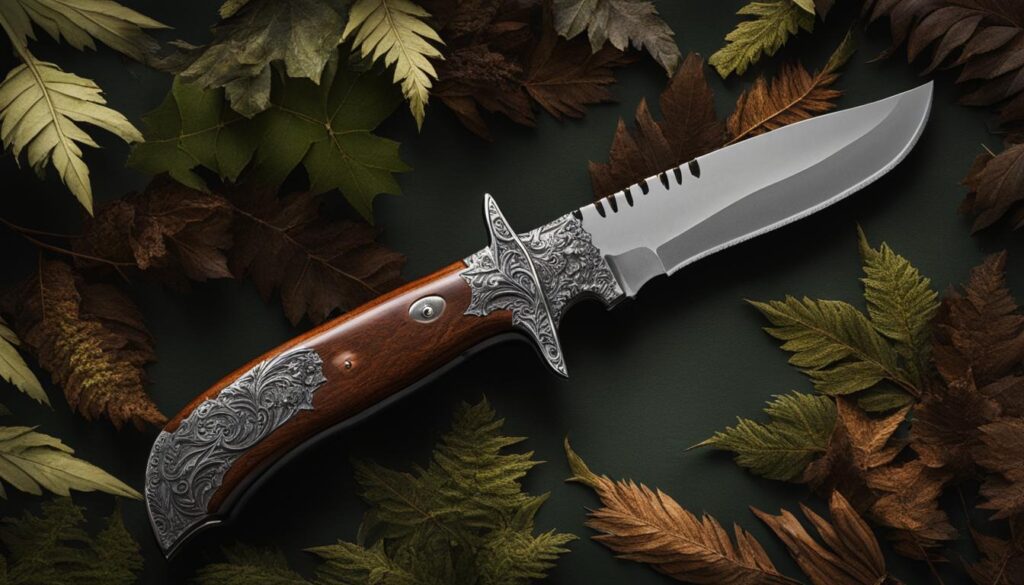

Conclusion
As a beginner in traditional hunting, choosing the right hunting knife is crucial for a successful hunting adventure. By understanding the history, uses, types, and optional features of hunting knives, you can make an informed decision and find the perfect knife for your needs.
When selecting a hunting knife, consider opting for beginner hunting knives or entry-level hunting knives. These knives are designed with the novice hunter in mind, offering a balance between quality and affordability. Classic hunting knives are also a popular choice, known for their timeless designs and reliable performance.
Remember to pay attention to the size and handle material of the knife. A comfortable grip and a durable handle are essential for a confident and secure hold. Additionally, understanding the different blade designs like clip point, drop point, and skinning blades will help you determine which suits your hunting style and needs best.
Investing in a high-quality hunting knife will ensure its durability and usability for years to come. With the right knife in hand, you can confidently navigate the world of traditional hunting and embark on exciting hunting adventures.
FAQ
What is the history of hunting knives?
Hunting knives have a rich history that dates back to the Stone Age when early humans used blades made from stone, shell, and bone for hunting. Significant contributions from individuals like Jim Bowie and R.W. Loveless have shaped the design of hunting knives over time.
What are the uses of hunting knives?
Hunting knives serve multiple purposes, including gutting, skinning, deboning, butchering, and caping. They are also useful for tasks like hog hunting.
What are the different types of hunting knives?
There are various types of hunting knives to choose from, including camp knives, Bowie knives, caping knives, skinning knives, boning knives, Buck knives, hunting daggers, and hunting sets.
What optional features can hunting knives have?
Hunting knives can have optional features like gut hooks for easier field dressing, different blade styles such as clip point, drop point, and skinning blades, and handle materials like G-10, Micarta, wood, or bone.
How can beginners choose the right hunting knife?
Beginners should consider the purpose of the knife, select the appropriate size and handle material, and understand the different blade designs. Investing in a high-quality hunting knife ensures durability and usability.
